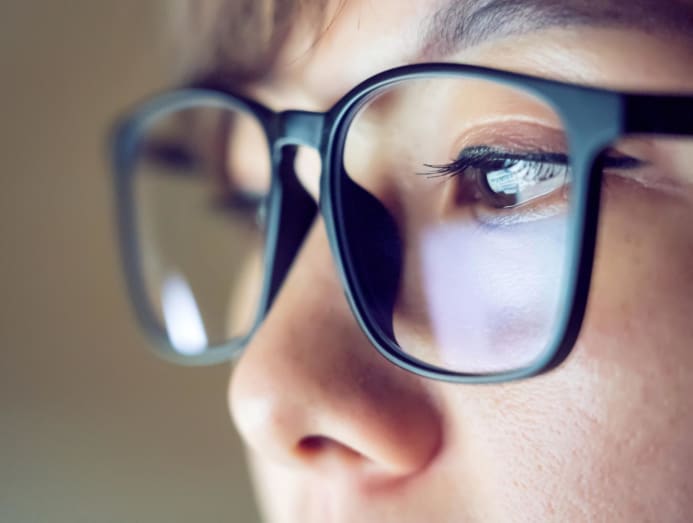Glaucoma in women: What to know about the silent eye condition that can lead to blindness
CNA Women asked the medical experts why women are at a higher risk of glaucoma, and why going for eye screening is more important than you think.

Glaucoma happens when raised eye pressure causes direct damage to the optic nerve, affecting the peripheral vision, or side vision of the eye. (Photo: iStock/PonyWang)
Did you know that glaucoma, an eye condition affecting the optic nerve, is the leading cause of irreversible blindness worldwide?
The optic nerve conveys messages from the eye to the brain and enables you to see. In glaucoma, increased pressure in the eye damages the optic nerve, which can eventually lead to permanent vision loss, said Dr Anoop Thomas, Principal Staff Physician at the Department of Ophthalmology and Visual Sciences at Khoo Teck Puat Hospital.
In Singapore, about 3 per cent of the population above 40 years suffers from glaucoma. What’s more, the eye disease is seen more commonly in women, said Dr Thomas. That’s because the prevalence of glaucoma increases with age – and women have an increased life expectancy.

Women also generally have smaller eyes than men and that puts us at increased risk for a subtype of the disease, called angle-closure glaucoma, said Dr Chua Wei Han, Medical Director and Senior Consultant Ophthalmologist at Mount Elizabeth Hospital.
GLAUCOMA IS A SILENT DISEASE
It’s important to note that most cases of glaucoma progress quietly until the disease reaches a very advanced stage, said Dr Thomas. A person who has early glaucoma won’t be able to observe changes in his or her vision.

“The disease is silent in early stages as it mainly affects the peripheral vision (side vision of the eye), which means that the central vision used for reading and most other daily tasks are unaffected until the disease is advanced,” he explained.
“Since the central vision is unaffected in the early stages, it is difficult for the patient to perceive that there is anything wrong with his or her vision,” he added.
The exception is for patients diagnosed with acute angle-closure glaucoma (a subtype of primary angle-closure glaucoma) which happens when increased eye pressure rises quickly. They would experience headaches, eye redness and blurred vision.
1. WHAT IS GLAUCOMA?
Glaucoma occurs when raised eye pressure causes direct damage to the optic nerve. Dr Thomas explained that the increase in eye pressure first affects peripheral vision. As glaucoma progresses, it causes the field of vision to become “narrower”, eventually affecting the central vision and causing blindness.
When blurry vision develops, the optic nerve damage is usually fairly advanced.
There are two main types of glaucoma. In primary glaucoma, the disease is genetic in nature and arises due to genetic mutations, said Dr Thomas. In secondary glaucoma, the disease happens due to other issues in the eye and body, such as eye trauma, inflammation, and eye complications from other medical conditions such as diabetes.
2. HOW IS GLAUCOMA DIAGNOSED?
It is diagnosed by an ophthalmologist through eye screening, where the eye specialist finds evidence of optic nerve damage in the brain, said Dr Chua. Both ophthalmologists and opticians use air puff tonometry (where a puff of air is blown to your eye) as a screening for elevated eye pressure, he added.

But remember – as glaucoma symptoms generally appear later in the course of the disease, having no perceptible symptoms does not mean that the optic nerve is totally normal, he added. “When blurry vision develops, the optic nerve damage is usually fairly advanced.”
This is why eye screening is so crucial.
Also, as glaucoma is primarily a genetic disease, lifestyle modification – which is beneficial in diseases like diabetes and hypertension – doesn’t help. “Eating better, sleeping better or exercising more will not affect the outcome of the disease,” Dr Thomas explained.
He added that there is also “no robust evidence” that says that consuming nutritional supplements can prevent the “onset or progression of glaucoma”.
3. WHO IS AT RISK OF GLAUCOMA? IS IT HEREDITARY?
Primary glaucoma is genetic in nature, said Dr Thomas, and therefore, can run in families.
His advice is to consider getting screened for it, especially if you are above 40 years of age, and if a close relative (your parents, siblings or first cousin) has been diagnosed with glaucoma.
Other common risk factors in younger people with glaucoma are use of steroids, eye trauma or surgery.
In addition to age and family history, Dr Chua added that other risk factors include:
- Race: Asians are at higher risk of primary angle-closure glaucoma.
- High myopia (short-sightedness): Local studies have shown that in people with low myopia (below 300 degrees), their risk of glaucoma is about two times time higher than those who have perfect vision. The risk increases to five times for those with myopia between 300 and 600 degrees. And it is 15 times higher for those with myopia above 600 degrees.
- Prolonged use of steroids: In certain patients, the frequent use of steroid eye drops over a period of just one to two weeks can cause eye pressure to go up.
- Eye trauma or eye surgery
- Certain medical conditions such as diabetes

Dr Chua recounted having a patient who developed glaucoma in both eyes when she was 24 years old. “Her main risk factor is high myopia, which in her case, was 2,500 degrees. Other common risk factors in younger people with glaucoma are use of steroids, eye trauma or surgery,” he added.
4. CHRONIC KIDNEY DISEASE AND GLAUCOMA – WHAT IS THE LINK?
According to a local study released in June this year, researchers from the Yong Loo Lin School of Medicine at the National University of Singapore found that there was a bi-directional link between chronic kidney disease and glaucoma. This means you have a risk of glaucoma if you suffer from chronic kidney disease, and similarly, having chronic kidney disease puts you at risk of developing glaucoma.
The researchers found that:
- Patients with chronic kidney disease have an 18 per cent higher risk of glaucoma.
- Patients with chronic kidney disease due to diabetes have a 42 per cent risk of glaucoma. For this group, glaucoma was more prevalent among patients from Asian countries including Singapore, Korea and China.
- After a period of 10 to 15 years, patients with glaucoma have close to four times increased risk of chronic kidney disease.
5. WHILE GLAUCOMA SEEMS TO BE MORE COMMON IN OLDER WOMEN, CAN IT AFFECT WOMEN IN THEIR TWENTIES OR THIRTIES, TOO?
There are two types of primary glaucoma that affect younger people: Congenital glaucoma and developmental glaucoma, which differ in age presentation, said Dr Thomas. It's a spectrum, he added.
Congenital glaucoma is when someone has the eye disease from birth, while developmental glaucoma presents during a person’s teen years to early adulthood, and can be silent in the beginning, just like adult onset glaucoma.
6. WILL I EVENTUALLY GO BLIND IF I HAVE GLAUCOMA?
It's a progressive eye condition that could lead to permanent vision loss, if left untreated. “Any damage to the optic nerve and consequent visual impairment or blindness cannot be reversed or cured,” said Dr Chua.
This is because “all current forms of treatment for glaucoma, be it medications or surgery, are aimed at lowering the intraocular (eye) pressure, which is a main risk factor for glaucoma,” he added.
The treatments either help to prevent the onset of glaucoma, such as nerve damage; or progression of glaucoma, which means further nerve damage. However, they cannot reverse any nerve damage, he explained.
CNA Women is a section on CNA Lifestyle that seeks to inform, empower and inspire the modern woman. If you have women-related news, issues and ideas to share with us, email CNAWomen [at] mediacorp.com.sg.








